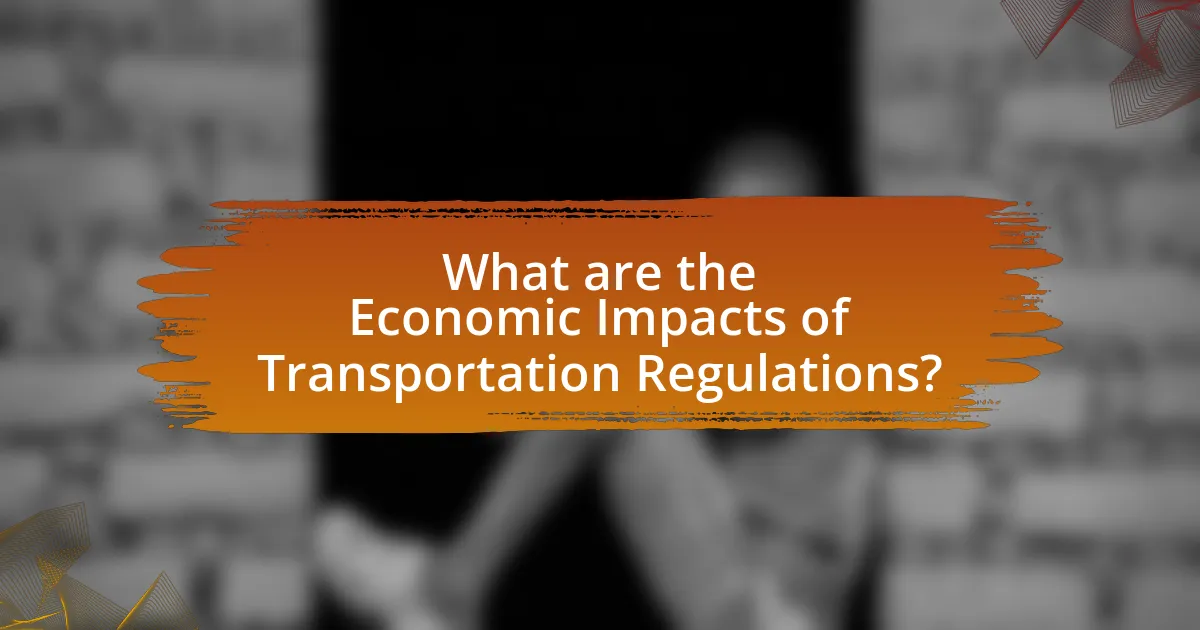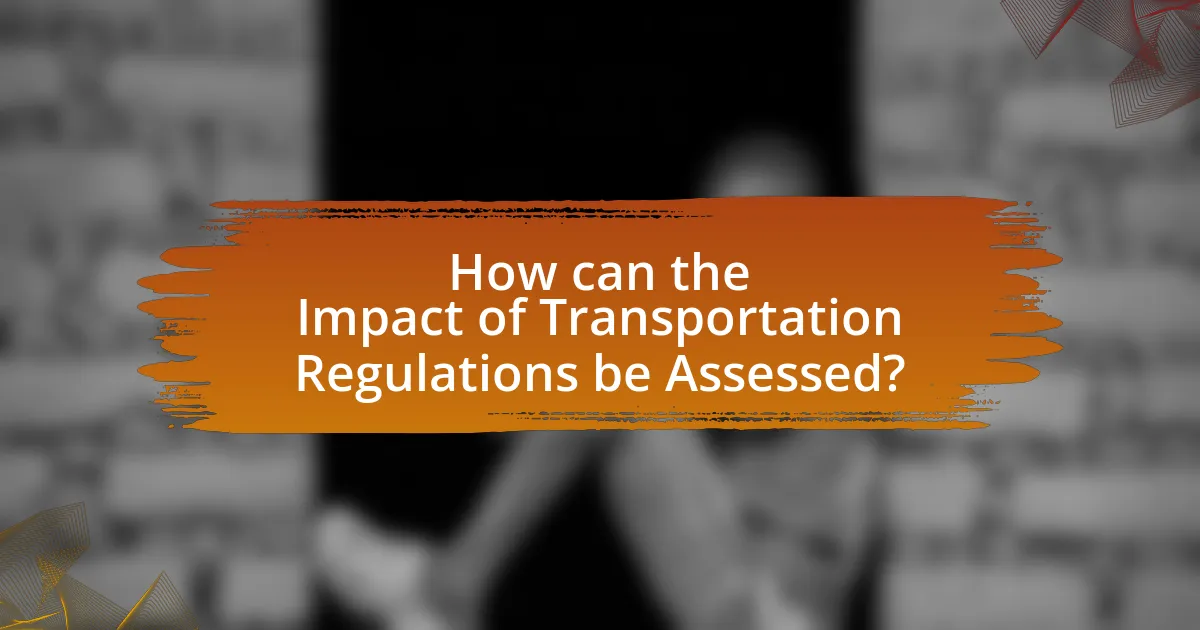Transportation regulations are essential rules established by government authorities to ensure the safety, efficiency, and environmental sustainability of transportation systems. This article examines the impact of these regulations on economic growth, highlighting how they influence operational costs, market accessibility, and competition among businesses. Key types of regulations, including safety, environmental, economic, and operational standards, are discussed, along with their varying applications across different regions. The article also explores the relationship between transportation regulations and job creation, the methodologies for assessing their economic impact, and the challenges faced in evaluation processes. By analyzing these factors, the article aims to provide a comprehensive understanding of how transportation regulations shape economic outcomes.

What are Transportation Regulations and Their Purpose?
Transportation regulations are rules and standards established by government authorities to govern the operation, safety, and efficiency of transportation systems. Their purpose is to ensure public safety, protect the environment, promote fair competition, and enhance the overall efficiency of transportation networks. For instance, regulations such as the Federal Motor Carrier Safety Administration’s hours-of-service rules aim to prevent driver fatigue, thereby reducing accidents and improving safety on the roads. Additionally, regulations like the Clean Air Act set emissions standards for vehicles, contributing to environmental protection. These regulations play a crucial role in shaping the transportation landscape, influencing economic growth by facilitating safe and efficient movement of goods and people.
How do Transportation Regulations influence economic activities?
Transportation regulations significantly influence economic activities by establishing standards that govern the efficiency, safety, and accessibility of transportation systems. These regulations can affect the cost of goods and services, as they dictate the operational parameters for transportation providers, including compliance costs and service quality. For instance, the implementation of stricter safety regulations can lead to increased operational costs for carriers, which may be passed on to consumers through higher prices. Additionally, regulations that enhance infrastructure investment can improve connectivity and reduce transit times, thereby fostering economic growth by facilitating trade and commerce. Historical data shows that countries with well-regulated transportation sectors often experience higher GDP growth rates, as efficient transportation systems are critical for supply chain optimization and market accessibility.
What are the key types of Transportation Regulations?
The key types of transportation regulations include safety regulations, environmental regulations, economic regulations, and operational regulations. Safety regulations ensure the protection of passengers and cargo, exemplified by the Federal Aviation Administration’s safety standards for airlines. Environmental regulations, such as the Clean Air Act, aim to minimize pollution from transportation sources. Economic regulations govern market entry and pricing, as seen in the Interstate Commerce Commission’s oversight of freight rates. Operational regulations dictate the operational practices of transportation entities, including hours of service for drivers to prevent fatigue. These categories collectively shape the transportation landscape and influence economic growth by ensuring safety, sustainability, and efficiency in the movement of goods and people.
How do these regulations vary across different regions?
Transportation regulations vary significantly across different regions due to factors such as local economic conditions, infrastructure capabilities, and political priorities. For instance, in North America, regulations tend to emphasize safety and environmental standards, leading to stringent requirements for vehicle emissions and safety inspections. In contrast, European regulations often focus on sustainability and reducing carbon footprints, resulting in policies that promote public transportation and electric vehicles. In developing regions, regulations may be less formalized, prioritizing rapid economic growth over stringent compliance, which can lead to inconsistent enforcement and varying standards. These differences are influenced by regional economic goals, public policy frameworks, and the level of infrastructure development, demonstrating how local contexts shape regulatory approaches.
Why are Transportation Regulations essential for economic growth?
Transportation regulations are essential for economic growth because they ensure safety, efficiency, and reliability in the movement of goods and people. These regulations create a structured environment that fosters competition, reduces transportation costs, and enhances market access. For instance, the Federal Motor Carrier Safety Administration reported that regulations aimed at improving safety standards have led to a significant decrease in road accidents, which in turn lowers costs for businesses and consumers. Additionally, efficient transportation systems, governed by regulations, facilitate trade by reducing delays and improving supply chain logistics, contributing to overall economic productivity.
What role do Transportation Regulations play in market accessibility?
Transportation regulations significantly influence market accessibility by establishing the legal framework that governs the movement of goods and services. These regulations determine the efficiency, safety, and cost of transportation, which directly affects how easily businesses can reach consumers and suppliers. For instance, regulations that streamline freight operations can reduce delivery times and costs, enhancing market access for companies. Conversely, stringent regulations may create barriers, limiting competition and increasing prices for consumers. Studies have shown that regions with favorable transportation regulations experience higher economic growth due to improved market accessibility, as evidenced by the correlation between regulatory environments and logistics performance indices.
How do Transportation Regulations impact competition among businesses?
Transportation regulations significantly impact competition among businesses by establishing rules that can either facilitate or hinder market entry and operational efficiency. For instance, stringent regulations may increase compliance costs for new entrants, thereby reducing competition as smaller firms struggle to meet these requirements. Conversely, regulations that promote safety and environmental standards can level the playing field by ensuring that all businesses adhere to the same criteria, which can enhance competition among established firms. According to a study by the American Transportation Research Institute, regulations that streamline processes and reduce bureaucratic hurdles can lead to increased competition, as they lower barriers to entry for new companies. Thus, the nature of transportation regulations directly influences the competitive landscape within various industries.

What are the Economic Impacts of Transportation Regulations?
Transportation regulations significantly influence economic impacts by shaping operational costs, market accessibility, and competition levels. For instance, regulations that impose safety standards and environmental controls can increase compliance costs for transportation companies, which may lead to higher prices for consumers. Conversely, effective regulations can enhance safety and efficiency, potentially reducing accident-related costs and improving overall productivity. A study by the American Transportation Research Institute found that regulatory compliance costs for the trucking industry alone exceeded $10 billion annually, illustrating the substantial financial burden regulations can impose. Additionally, regulations that promote fair competition can lead to lower prices and improved services, ultimately benefiting consumers and stimulating economic growth.
How do Transportation Regulations affect transportation costs?
Transportation regulations significantly increase transportation costs by imposing compliance requirements, safety standards, and operational restrictions on carriers. These regulations often necessitate investments in technology, training, and infrastructure to meet legal standards, which can lead to higher operational expenses. For instance, the Federal Motor Carrier Safety Administration’s regulations on driver hours of service and vehicle maintenance require trucking companies to allocate resources for compliance, thereby raising overall costs. Additionally, regulations can limit competition by creating barriers to entry, which can further inflate prices for consumers.
What factors contribute to changes in transportation costs due to regulations?
Changes in transportation costs due to regulations are primarily influenced by compliance costs, fuel taxes, and safety standards. Compliance costs arise from the need for companies to adhere to regulatory requirements, which can increase operational expenses. For instance, the implementation of the Electronic Logging Device (ELD) mandate in the U.S. led to increased costs for trucking companies due to the need for new technology and training. Fuel taxes directly affect transportation costs by increasing the price of fuel, which is a significant expense for transportation providers. According to the American Transportation Research Institute, fuel costs account for approximately 24% of total trucking operational costs. Additionally, safety standards, such as those enforced by the Federal Motor Carrier Safety Administration, can necessitate investments in vehicle upgrades and maintenance, further impacting overall transportation costs.
How do increased transportation costs influence consumer prices?
Increased transportation costs directly lead to higher consumer prices. When transportation expenses rise, businesses often pass these costs onto consumers in the form of increased prices for goods and services. For instance, a study by the Federal Reserve Bank of St. Louis found that a 10% increase in transportation costs can result in a 1.5% increase in consumer prices. This relationship is particularly evident in industries heavily reliant on logistics, such as retail and food distribution, where transportation constitutes a significant portion of overall costs.
What is the relationship between Transportation Regulations and job creation?
Transportation regulations significantly influence job creation by establishing standards that ensure safety, efficiency, and environmental protection in the transportation sector. These regulations can lead to job growth in various ways, such as by promoting infrastructure development, which requires a workforce for construction, maintenance, and operation. For instance, the Federal Highway Administration reported that every $1 billion invested in transportation infrastructure supports approximately 13,000 jobs. Additionally, regulations that encourage innovation and competition can stimulate new business opportunities, further contributing to job creation. Thus, effective transportation regulations not only safeguard public interests but also serve as a catalyst for economic growth and employment.
How do regulations impact employment in the transportation sector?
Regulations significantly impact employment in the transportation sector by establishing safety standards, operational guidelines, and labor practices that directly influence job creation and workforce stability. For instance, the Federal Motor Carrier Safety Administration’s Hours of Service regulations dictate driving hours for truck drivers, which can affect the number of drivers needed to meet delivery demands. Additionally, regulations such as the Clean Air Act impose environmental standards that may require transportation companies to invest in cleaner technologies, potentially leading to job creation in green technology sectors while also risking job losses in traditional roles. According to the American Public Transportation Association, public transit regulations can enhance job opportunities by increasing ridership and funding, which supports more positions in transit agencies. Thus, while regulations can create jobs in certain areas, they may also lead to job displacement in others, illustrating a complex relationship between regulatory frameworks and employment dynamics in the transportation sector.
What are the indirect effects of Transportation Regulations on job growth in other sectors?
Transportation regulations can indirectly affect job growth in other sectors by influencing logistics costs, supply chain efficiency, and overall economic activity. For instance, stricter regulations may increase transportation costs, leading businesses to pass these costs onto consumers, which can reduce demand in sectors like retail and manufacturing. Additionally, regulations that improve safety and environmental standards can enhance public health and reduce costs associated with accidents and pollution, potentially leading to job growth in healthcare and environmental sectors. Studies have shown that regions with efficient transportation systems tend to experience higher job growth across various industries, as these systems facilitate trade and attract investment.

How can the Impact of Transportation Regulations be Assessed?
The impact of transportation regulations can be assessed through a combination of quantitative analysis, case studies, and stakeholder surveys. Quantitative analysis involves examining economic indicators such as freight costs, transit times, and accident rates before and after regulation implementation, which can reveal changes in efficiency and safety. For instance, a study by the Federal Highway Administration found that stricter safety regulations led to a 25% reduction in truck-related fatalities over a decade. Case studies of specific regions or industries affected by regulations provide qualitative insights into operational changes and economic outcomes. Additionally, stakeholder surveys can capture the perspectives of businesses and consumers regarding the perceived effects of regulations on transportation costs and service quality. This multi-faceted approach ensures a comprehensive understanding of the regulations’ impacts on economic growth.
What methodologies are used to evaluate the economic impact of Transportation Regulations?
The methodologies used to evaluate the economic impact of transportation regulations include cost-benefit analysis, econometric modeling, and input-output analysis. Cost-benefit analysis quantifies the economic advantages and disadvantages of regulations by comparing the costs incurred with the benefits gained, often using historical data to project future impacts. Econometric modeling employs statistical techniques to analyze relationships between transportation regulations and economic indicators, allowing for the assessment of causal effects. Input-output analysis examines the interdependencies between different sectors of the economy, providing insights into how changes in transportation regulations affect overall economic activity. These methodologies are validated through empirical studies that demonstrate their effectiveness in capturing the economic implications of transportation regulations.
How do quantitative analyses contribute to understanding these impacts?
Quantitative analyses contribute to understanding the impacts of transportation regulations on economic growth by providing measurable data that reveals relationships between regulatory changes and economic indicators. For instance, studies have shown that a 10% increase in transportation efficiency can lead to a 2% increase in GDP, demonstrating a direct correlation between regulatory improvements and economic performance. By employing statistical methods, researchers can isolate variables, control for confounding factors, and establish causality, thereby offering concrete evidence of how specific regulations influence economic outcomes. This data-driven approach allows policymakers to make informed decisions based on empirical evidence, ultimately enhancing the effectiveness of transportation regulations in promoting economic growth.
What qualitative factors should be considered in the assessment?
Qualitative factors to consider in the assessment of transportation regulations on economic growth include stakeholder perceptions, regulatory compliance costs, and the impact on community well-being. Stakeholder perceptions influence how regulations are accepted and implemented, affecting overall economic activity. Regulatory compliance costs can burden businesses, potentially stifling growth if they are perceived as excessive. Additionally, the impact on community well-being, such as improved safety and reduced congestion, can enhance quality of life and indirectly support economic growth. These factors are critical for a comprehensive understanding of the regulations’ effects on economic outcomes.
What are the challenges in assessing the impact of Transportation Regulations?
Assessing the impact of Transportation Regulations faces several challenges, primarily due to the complexity of transportation systems and the multifaceted nature of economic growth. One significant challenge is the difficulty in isolating the effects of specific regulations from other influencing factors, such as market conditions, technological advancements, and consumer behavior. For instance, a study by the National Bureau of Economic Research found that attributing changes in economic performance directly to transportation regulations is complicated by these external variables. Additionally, data availability and quality can hinder accurate assessments, as comprehensive datasets that track the long-term effects of regulations on various economic indicators are often lacking. Furthermore, the dynamic nature of transportation networks and the evolving regulatory landscape can make it challenging to establish consistent metrics for evaluation.
How do data limitations affect the evaluation process?
Data limitations significantly hinder the evaluation process by restricting the availability and quality of information necessary for accurate assessments. In the context of evaluating transportation regulations’ impact on economic growth, insufficient or unreliable data can lead to flawed conclusions, as seen in studies where incomplete datasets resulted in misleading correlations between regulatory changes and economic indicators. For instance, a lack of comprehensive data on transportation infrastructure investments can obscure the true effects of regulations on economic performance, making it difficult to establish causality. Consequently, these limitations can undermine the credibility of evaluations and hinder informed decision-making.
What biases might influence the interpretation of results?
Biases that might influence the interpretation of results include confirmation bias, selection bias, and publication bias. Confirmation bias occurs when researchers favor information that supports their pre-existing beliefs about transportation regulations and economic growth, potentially leading to skewed conclusions. Selection bias arises when the sample of data analyzed does not accurately represent the broader population, which can distort the perceived impact of regulations. Publication bias refers to the tendency for studies with positive results to be published more frequently than those with negative or inconclusive findings, thereby affecting the overall understanding of the relationship between transportation regulations and economic growth. These biases can significantly alter the interpretation of research outcomes, leading to misleading policy implications.
What best practices can be adopted for effective assessment of Transportation Regulations’ impact?
To effectively assess the impact of Transportation Regulations, it is essential to adopt a systematic approach that includes data collection, stakeholder engagement, and performance metrics. First, comprehensive data collection should encompass traffic patterns, accident rates, and economic indicators to establish a baseline for analysis. For instance, the Federal Highway Administration reports that data-driven assessments can reveal correlations between regulations and safety improvements.
Second, engaging stakeholders such as transportation agencies, businesses, and community members ensures diverse perspectives are considered, enhancing the assessment’s relevance and accuracy. Research by the Transportation Research Board emphasizes that stakeholder involvement can lead to more informed decision-making and better regulatory outcomes.
Lastly, establishing clear performance metrics allows for the evaluation of regulatory effectiveness over time. Metrics such as changes in travel time, cost savings, and environmental impacts provide quantifiable evidence of a regulation’s success or failure. The National Cooperative Highway Research Program highlights that using specific, measurable indicators can significantly improve the assessment process.
By implementing these best practices, the assessment of Transportation Regulations can yield actionable insights that support economic growth and enhance public safety.


